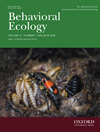Studies on the whole range of behaving organisms, including plants, invertebrates, vertebrates, and humans, are included.Behavioral Ecology construes the field in its broadest sense to include 1) the use of ecological and evolutionary processes to explain the occurrence and adaptive significance of behavior patterns; 2) the use of behavioral processes to predict ecological patterns, and 3) empirical, comparative analyses relating behavior to the environment in which it occurs.
行为生态学包括对行为生物的研究,包括植物、无脊椎动物、脊椎动物和人类。行为生态学从最广泛的意义上解释这一领域,包括:1)使用生态和进化过程来解释行为模式的发生和适应意义; 2)使用行为过程来预测生态模式,以及3)将行为与其发生的环境相关联的经验性、比较性分析。
Causes and consequences of intraspecific variation in animal responses to anthropogenic noise
来源期刊:Behavioral EcologyDOI:10.1093/beheco/arz114
Systematic reviews and maps as tools for applying behavioral ecology to management and policy
来源期刊:Behavioral EcologyDOI:10.1093/beheco/ary130
The nutritional ecology of maturation in a carnivorous insect
来源期刊:Behavioral EcologyDOI:10.1093/beheco/ary142
Achromatic plumage brightness predicts stress resilience and social interactions in tree swallows (Tachycineta bicolor)
来源期刊:Behavioral EcologyDOI:10.1093/BEHECO/ARZ010
Natal habitat and sex-specific survival rates result in a male-biased adult sex ratio
来源期刊:Behavioral EcologyDOI:10.1093/beheco/arz021
Fighting in rounds: males of a neotropical cricket switch assessment strategies during contests
来源期刊:Behavioral EcologyDOI:10.1093/BEHECO/ARZ005
Assortative interactions revealed in a fission–fusion society of Australian humpback dolphins
来源期刊:Behavioral EcologyDOI:10.1093/BEHECO/ARZ029
Assessing reliance on vector navigation in the long‐distance oceanic migrations of green sea turtles
来源期刊:Behavioral EcologyDOI:10.1093/beheco/ary166
Optimal foraging or surplus killing: selective consumption and discarding of salmon by brown bears
来源期刊:Behavioral EcologyDOI:10.1093/beheco/ary139
Counting crows: population structure and group size variation in an urban population of crows
来源期刊:Behavioral EcologyDOI:10.1093/beheco/ary157
Pale by comparison: competitive interactions between signaling female glow‐worms
来源期刊:Behavioral EcologyDOI:10.1093/beheco/ary161
Within‐individual variation in sexual displays: signal or noise?
来源期刊:Behavioral EcologyDOI:10.1093/beheco/ary165
Socio-ecological conditions and female infidelity in the Seychelles warbler
来源期刊:Behavioral EcologyDOI:10.1093/beheco/arz072
Do zombie ant fungi turn their hosts into light seekers
来源期刊:Behavioral EcologyDOI:10.1093/BEHECO/ARY198
Offspring dispersal ability covaries with nest‐site choice
来源期刊:Behavioral EcologyDOI:10.1093/beheco/ary154
Are signals of aggressive intent less honest in urban habitats
来源期刊:Behavioral EcologyDOI:10.1093/beheco/arz179
Contest dynamics and assessment strategies in combatant monkey beetles (Scarabaeidae: Hopliini)
来源期刊:Behavioral EcologyDOI:10.1093/BEHECO/ARZ008
The effects of experimental design on mating preferences and reproductive isolation in killifish
来源期刊:Behavioral EcologyDOI:10.1093/beheco/ary150
Breeding success but not mate choice is phenotype- and context-dependent in a color polymorphic raptor
来源期刊:Behavioral EcologyDOI:10.1093/BEHECO/ARZ013
Diet and provisioning rate differ predictably between dispersing and philopatric pied flycatchers
来源期刊:Behavioral EcologyDOI:10.1093/beheco/ary152
Evidence for dominant males but not choosy females in an insular rock iguana
来源期刊:Behavioral EcologyDOI:10.1093/beheco/ary131
Innovative consumers: ecological, behavioral, and physiological predictors of responses to novel food
来源期刊:Behavioral EcologyDOI:10.1093/BEHECO/ARZ067
Temporal plasticity in habitat selection criteria explains patterns of animal dispersal
来源期刊:Behavioral EcologyDOI:10.1093/beheco/ary193
Individual differences exceed species differences in the movements of a river fish community
来源期刊:Behavioral EcologyDOI:10.1093/BEHECO/ARZ076
Experimental traffic noise attracts birds during the breeding season
来源期刊:Behavioral EcologyDOI:10.1093/BEHECO/ARZ123
Size and contrast increase the divertive effect of eyespots
来源期刊:Behavioral EcologyDOI:10.1093/beheco/ary149
Effects of condition and sperm competition risk on sperm allocation and storage in neriid flies
来源期刊:Behavioral EcologyDOI:10.1093/beheco/arz178
Female preference for novel males constrains the contemporary evolution of assortative mating in guppies
来源期刊:Behavioral EcologyDOI:10.1093/BEHECO/ARY202
Nestling and adult sparrows respond differently to conspecific dialects
来源期刊:Behavioral EcologyDOI:10.1093/beheco/ary148
Juvenile plumage whiteness is associated with the evolution of clutch size in passerines
来源期刊:Behavioral EcologyDOI:10.1093/BEHECO/ARZ058
In a noisy world, some animals are more equal than others: a response to comments on Harding et al.
来源期刊:Behavioral EcologyDOI:10.1093/beheco/arz171
Selective attention by priming in host search behavior of 2 generalist butterflies
来源期刊:Behavioral EcologyDOI:10.1093/beheco/ary146
Influence of preexisting preference for color on sampling and tracking behavior in bumble bees
来源期刊:Behavioral EcologyDOI:10.1093/beheco/ary140
Intraspecific variation in animal responses to anthropogenic noise through long-term monitoring: a comment on Harding et al.
来源期刊:Behavioral EcologyDOI:10.1093/beheco/arz161
Variation in chick-a-dee call sequences, not in the fine structure of chick-a-dee calls, influences mobbing behaviour in mixed-species flocks
来源期刊:Behavioral EcologyDOI:10.1093/beheco/arz155
Acoustic stability in hyrax snorts: vocal tightrope‐walkers or wrathful verbal assailants?
来源期刊:Behavioral EcologyDOI:10.1093/beheco/ary141
The effects of stress and glucocorticoids on vocalizations: a test in North American red squirrels
来源期刊:Behavioral EcologyDOI:10.1093/BEHECO/ARZ044
Context-dependent strategies of food allocation among offspring in a facultative cooperative breeder
来源期刊:Behavioral EcologyDOI:10.1093/BEHECO/ARZ037
Local mate competition modifies the costs of mating in a mostly monandrous parasitoid wasp
来源期刊:Behavioral EcologyDOI:10.1093/BEHECO/ARY181
Does bat response to traffic noise support the misleading cue hypothesis
来源期刊:Behavioral EcologyDOI:10.1093/beheco/arz148
Burrow usage patterns and decision-making in meerkat groups
来源期刊:Behavioral EcologyDOI:10.1093/beheco/arz190
Flexible polyandry in female flies is an adaptive response to infertile males
来源期刊:Behavioral EcologyDOI:10.1093/BEHECO/ARZ140
Do wolf spiders’ egg-sacs emit tactochemical signals perceived by mothers?
来源期刊:Behavioral EcologyDOI:10.1093/BEHECO/ARY197
Computerized stimuli for studying oddity effects
来源期刊:Behavioral EcologyDOI:10.1093/beheco/arz174
Male spacing and female choice in a fiddler crab
来源期刊:Behavioral EcologyDOI:10.1093/beheco/arz147
Group size and social status affect scent marking in dispersing female meerkats
来源期刊:Behavioral EcologyDOI:10.1093/BEHECO/ARZ124
Reproductive conflict resolution in cooperative breeders
来源期刊:Behavioral EcologyDOI:10.1093/beheco/arz143
Better safe than sorry: spider societies mitigate risk by prioritizing caution
来源期刊:Behavioral EcologyDOI:10.1093/BEHECO/ARZ069
Marriage stability in a pastoralist society
来源期刊:Behavioral EcologyDOI:10.1093/beheco/arz115
Applying Lanchester’s laws to the interspecific competition of coral reef fish
来源期刊:Behavioral EcologyDOI:10.1093/BEHECO/ARY182




